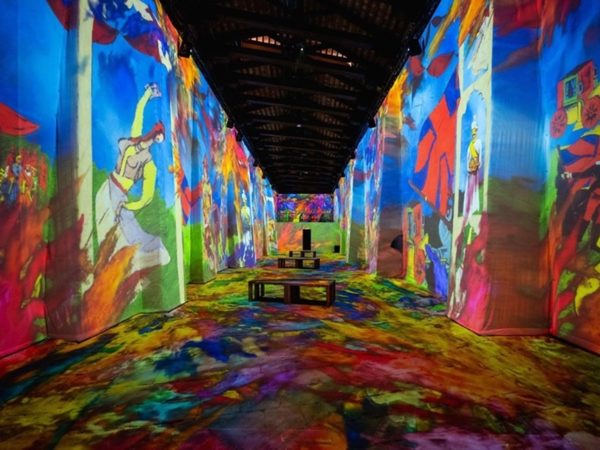Emami Art Celebrates 60 Years of Jogen Chowdhury’s Work with Retrospective Exhibition
“Jogen Chowdhury is in the highest sense of the word, a fabulist, a storyteller. We are invited to speculate about the inner lives of his protagonists: the concupiscent or estranged couple, the tonsured monk, the dreaming boy, the ageing libertine and the courtesan whose limbs have lost their tautness,” says Ranjit Hoskote, Curator.

Jogen Chowdhury, Reminiscence of a Dream – 1, 1969
Out of all the texts surrounding the artwork, this sentence stands out for me as I take in the sheer size and scope of Reverie and Reality, the Jogen Chowdhury retrospective currently showing at the Kolkata Centre for Creativity. At eighty, he is a prominent figure on the Indian art scene, part of a generation that shaped contemporary Indian art, coming of age as they did in a newly created sovereign nation. The exhibition, an ode to his life’s work, spans six decades and unites different phases and mediums into an unfolding narrative that leaves us with a deep understanding of his oeuvre.

Jogen Chowdhury, Still Life, 1970
Jogen Chowdhury was born in Faridpur, in pre-partition India and was only 8 years old when his family had to trade their comfortable, well established life for one of extreme hardship and uncertainty. The experience of spending his formative years in a south Calcutta refugee colony has greatly influenced his art, revealed in the uncompromising brutality of his vision, brushed with an underlying empathy.
Curator Ranjit Hoskote is a poet, art critic and curator, who has previously curated exhibitions for the National Gallery of Modern Art in Mumbai, New Delhi, and Bangalore as well as shows at the Venice Biennale, the Serendipity Arts Festival, Goa, and many more. In Reverie and Reality he has brought together artworks from 1955 to 2015, including pieces owned by private collectors such as Shah Rukh and Gauri Khan, Masanori Fukuoka, Dadiba and Khorshed Pundole, as well as those from galleries like the Delhi Art Gallery and Gallery Mirchandani and Steinruecke. In doing so he has created a comprehensive and intimate portrait of the artist himself. Walking through the exhibition is like taking a stroll through Chowdhury’s life.

Jogen Chowdhury, Reminiscence of a Dream – 5, 1969
As a young student of the Government College of Art and Craft, Kolkata, his art was more studied and academic, and we can see the influence of the formal training he was receiving at the time. Over the years we observe his style evolve and become increasingly distinctive – the intricate cross-hatching already begin to emerge in his work. But it is in the late 1960s, after Chowdhury’s stint in École des Beaux-Arts, Paris, that he really comes into his own, his work characterised by the typical bold lines and strong hand that were to become his signature. By the 80s he has firmly established the way he uses space, filling the surface with his figures.

Jogen Chowdhury, Portrait, 1980
“Chowdhury’s cross-hatching works, their velvety black textures rendered against crisp white, have evolved from his childhood experience of sketching by the light of a hurricane lamp,” says Hoskote. This is a technique that we see right from the beginning, but over the years it develops into one of his more distinctive features. Another aspect of Chowdhury’s work that is present throughout his career is his keen eye and versatility in capturing and expressing emotion. He is an adept storyteller, his arresting visuals drawing viewers in, allowing them to form their own conclusions about what’s playing out in the scene before them.
Adding to the atmosphere of the exhibition are the excerpts from the artist’s sketchbooks and personal photographs on display. Casual sketches, doodles and handwritten notes, interspersed with candid snapshots of Chowdhury with friends and family, give us a behind-the-scenes glimpse of his personal life. We come away from this exhibition with a sense of satisfaction about having had the chance to witness an entire life’s work, and its evolution through different phases of time. We come away from this exhibition with a better understanding of the veritable force of Jogen Chowdhury’s art.
Text by Diya Katyal







